Why do arc furnace transformers and inrush currents cause voltage sags?
An electric arc furnace is a device that melts metal using the high temperature generated by an electric arc. It converts electrical energy into thermal energy through a transformer, then transfers the heat via the arc to the furnace charge, causing it to melt. When the arc furnace starts operating, the transformer load increases suddenly, leading to a drop in grid voltage. Additionally, due to the operational characteristics of the arc furnace, the load continues to rise over a period of time, which may result in a significant voltage sag. Conversely, when the arc furnace stops, the sudden reduction in transformer load can cause a rise in grid voltage, resulting in a voltage swell.
During arc furnace operation, as the melting and cooling of the charge generate substantial heat, continuous power supply is required. If faults or operational errors occur during power delivery, sympathetic inrush currents (also known as magnetizing inrush currents) may be triggered, further affecting grid stability.
Statistics show that transformer sympathetic inrush currents impact voltage sags in two main ways: first, they cause a sudden increase in grid current, exacerbating the magnitude of voltage sags; second, they may lead to grid voltage instability, increasing the frequency of voltage sags. To prevent voltage sags caused by sympathetic inrush currents in arc furnace transformers, the following three measures are recommended:
- Optimize arc furnace operation and adjust transformer parameters: Improve operational procedures and fine-tune transformer settings to effectively reduce the magnitude of voltage sags.
- Adjust arc furnace operating frequency and transformer load ratio: Properly configure the furnace's operating frequency and load ratio to mitigate the severity of voltage sags.
- Install voltage sag compensation devices: Monitor grid voltage in real time and automatically activate compensation equipment during voltage sags to restore grid voltage to normal levels.
Understanding that arc furnace transformers and sympathetic inrush currents are key contributors to voltage sags enables targeted measures to reduce their impact, thereby enhancing the efficiency and stability of power system operations.
Time is limited, so this concludes today’s discussion. If you would like to learn more about transformer magnetizing inrush currents and mitigation methods, feel free to leave a comment!
Hello! I'm Leon, with 20 years of extensive experience in the power industry. My expertise spans from power distribution equipment to grid operations and maintenance, grounded in robust hands-on and theoretical knowledge. Currently, I focus on sharing insights into electrical equipment fault diagnosis, demystifying complex technical challenges through accessible explanations. I welcome collaboration with industry peers and enthusiasts to collectively explore the intricacies of the power sector.













